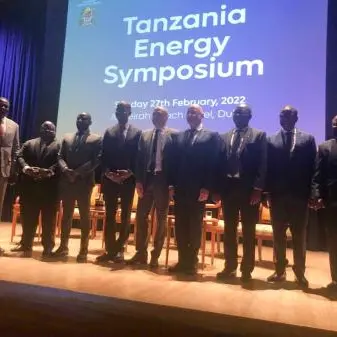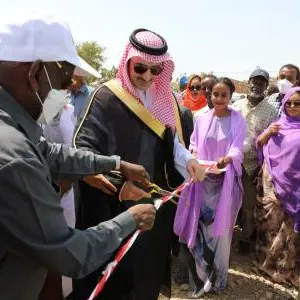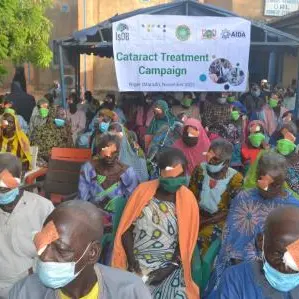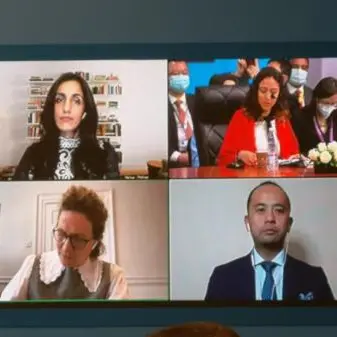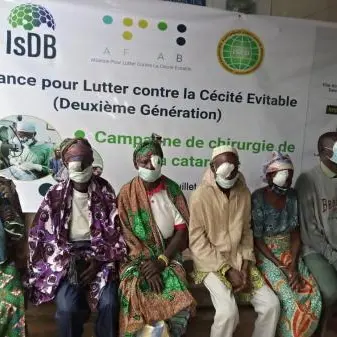Hundreds of truckloads of World Food Programme assistance are speeding this month to the hungriest parts of Sudan, as part of a massively scaled-up response after famine was confirmed at a camp for displaced people in the country’s Darfur region.
Targeting an initial 3 million people this month, the WFP food-and-cash support aims to prevent more people from falling into catastrophic hunger, one of the most horrific fallouts of the conflict in Sudan.
In war-torn Khartoum, we recently distributed food and nutrition assistance to a hungry population for the first time in months. WFP is also supporting community kitchens – neighborhood volunteer groups that have become a vital food lifeline for Sudanese countrywide, especially in the capital.
“We can still turn the tide against hunger and famine in Sudan,” said WFP Sudan Emergency Coordinator Marco Calvacante. “We can still make it.”
But reaching millions of desperate people demands unfettered humanitarian access, safe passage, and a massive influx of funds. Overall, WFP needs US$459 million for its emergency response to support up to 8.4 million hungry people in Sudan by the end of this year.
“We need this conflict to end. We need unimpeded access to reach those most in need,” Calvacante said. “We need the attention of the world to focus on Sudan.”
Famine confirmed
In late July, the global standard for measuring food insecurity – the Integrated Food Phase Classification or IPC – confirmed famine in Zamzam camp, which houses more than 400,000 displaced people outside the besieged North Darfur city of El Fasher.
This was a first for Sudan, and it's only the third famine confirmation worldwide since the IPC was first implemented 20 years ago – 13 other areas in the country are at risk of famine in the coming months.
“Our biggest challenge is the continuation of this conflict which hampers our movement as well as the safe delivery of humanitarian supplies,” said WFP Sudan Country Director Eddie Rowe. ”We call on the parties for an immediate cessation of hostilities.”
Sudan's is now the world’s largest displacement crisis. Since it started 16 months ago, the war has triggered a hunger spiral engulfing tens of millions of people countrywide. The fighting has ravaged Sudanese food production, destroyed essential markets, and cut off communities large and small from vital assistance. Along with heavy fighting, the rainy season poses another major setback in delivering assistance, with flooded roads grounding dozens of WFP aid trucks.
According to IPC figures for June, nearly 26 million Sudanese face acute food insecurity. Nearly 750,000 people countrywide face catastrophic food insecurity, the highest hunger level. Roughly 730,000 children are projected to experience potentially life-threatening severe acute malnutrition this year.
In the Darfur region, WFP Security Officer Khalid Hamdnalla describes meeting scores of hungry, displaced people during a recent United Nations interagency mission to assess humanitarian needs.
“We saw whole families, including children and elders, who don’t have enough food. Some have been displaced more than three times,” said Hamdnalla of those they met, some of whom are sheltering in abandoned schools and other government buildings. “Their main requests were for food, education, sanitation and health services.”
“The host communities are hungry as well,” he adds, “because they’ve shared what they had with the displaced people.”
The UN mission crossed many armed checkpoints, but heavy rains proved the biggest challenge, making some wadis, or seasonal rivers, impassable. “You cannot imagine the road conditions with the rains,” Hamdnalla says. “There are big wadis, and the current is very fast – it’s very dangerous.”
Few safe options
In late July, WFP was able to reach Sudan’s capital Khartoum for the first time since March, allowing us to deliver two-month rations of sorghum, lentils, oil and salt to people. Many we reached are elderly or otherwise unable to flee the conflict’s frontlines. The fighting has reduced swathes of the city to rubble, including Khartoum’s iconic and all-important Omdurman market – delivering a blow to the country’s food supply and economy.
Over 90,000 people in the greater Khartoum area are on the brink of famine; more than 1 million are experiencing emergency hunger levels. Yet people are trickling back to the capital – not because it is safer, but because there are few safe options after months on the run.
“They starting coming back to their houses, but unfortunately they don’t have anything inside – they even don’t have a job because of the war,’ says Khalid Mohamed Elbaghir, a volunteer with one of Khartoum’s community kitchens. “So we started supplying them with food to make them stay more easily in this neighborhood.”
WFP is supporting neighborhood kitchens like Elbaghir’s, which provide soup and other staples to city residents. The overall aim is to distribute up to 140,000 hot meals daily. For many elderly and other vulnerable people in the capital, it is their only meal of the day.
“Often two or three days passed without us being able to go out and get food – sometimes we’d be trapped in our homes for a week,” says Maya, a former tea seller in Khartoum. “If we tried to leave, we would get beaten in the street and robbed of money and food.”
Other Sudanese are seeking safety elsewhere in the country. Amna Yousif’s family fled their home in war-buffeted Sennar state, walking and hitching truck rides for eight days before reaching the relatively secure seaside city of Port Sudan. “We got up at 2 a.m. on a rainy night, carrying the children in our arms and walking through the night in the mud,” she recalled of their flight.
Today, the family lives in a tent in an abandoned lot in Port Sudan.
“When I left my house I left the okra flourishing and the molokhia (mallow) ready for harvest,” Yousif recalled of the local vegetables she grew – and of better times, when her family lived without hunger. “One of the good things about our village is that when you sow with your hand, you eat and drink.”
Distributed by APO Group on behalf of World Food Programme (WFP).
